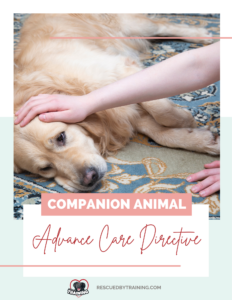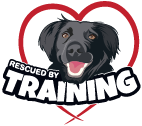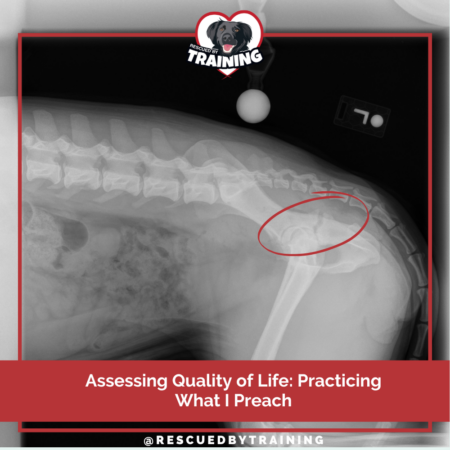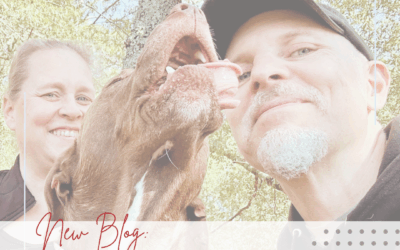We recently adopted a new dog, Gertie, aka Gertrude Wigglebottom, a little over ten months after we said goodbye to our precious BooBoo. Surprisingly, adopting a new dog dredged up lots of grief feelings about Boo, which I’ll talk about another time.
I wanted to share more about quality of life (QOL) assessments and why I am so passionate about QOL and end of life planning, both for humans and animals, I always want people to think ahead and have plans in place. I strongly believe that planning reduces stress in the long-term. My post What If Your Animal Outlives You? talks about proactively thinking about difficult things and making arrangements for your animals in the event that they outlive you. Sure, these are tough things to think about, but having plans in place is better than having to scramble if you’re suddenly diagnosed with something terminal, or in an accident and your animals are left stranded and maybe left to be brought to a shelter.
This hit home recently, just 4 days after adopting Gertie. We had fostered her for several weeks before we foster failed and noticed in that foster window that she would limp or not bear weight when running. I suspected she had a CCL tear or maybe some hip dysplasia. So, we scheduled an orthopedic consult for her but before the appointment came, we foster failed. On day 4 after signing her adoption papers, we had our ortho consult, which turned out to be almost 2 hours long and the news was not good. It was the worst case scenario I could have ever imagined. I expected one problem that would need resolution but in fact, it was 5 separate diagnoses, with a price tag of about $20K to do all three surgeries. I was devastated and came home and sobbed for hours.
Gertie was a stray so it wasn’t a complete surprise that the x-rays revealed a hip fracture. She likely got clipped by a car and it broke her left hip, resulting in the femoral head displacing and rubbing in ways it shouldn’t. It looks like her body is trying to close the fracture and that might happen on its own with more time. “Great, I thought! That explains it!”
But then the surgeon continued. She could have less pain with a total hip replacement or femoral head ostectomy (FHO). “OK, we’ll think about that” thinking that was the diagnosis and we’d be on our way.
But then the surgeon continued. She also has some CCL swelling and fluid in her knee, possibly related to the hip or maybe she just has cruciate disease that is genetic, in which case it would affect both knees. CCL injuries typically don’t get MRIs in dogs, like they do people, so the diagnosis of made off symptoms, but in this case it’s fuzzy, because there’s likely pain from the hip fracture and ball/socket being out of whack. So that would be two different surgeries. Hip and knee at different times.
“OK, we’ll figure that out.”
And then he continued. On the other “good” leg, she has grade 2 luxating patella, some mild CCL movement/instability, possible due to cruciate disease or maybe due to overcompensating from the bad left leg not fully weight bearing at all times. Oh and she’s got mild hip dysplasia.
Bombshell.
Total surgery costs if everything is done/needed about $20K.
I was stunned. I found myself zoning out and staring at the floor. I was too shocked to cry in the consult room. I was numb, just trying to take in all the information he was saying.
I managed to ask some questions including about medical management, like medication (NSAID and injections like Adequan, which I had done for both Barbo and Boo), supplements and PT exercises, since I have a ton of FitPaws stuff. He said she could do all of that, and recommended redoing x-rays in several months to see if the fracture has made more progress closing.
Often in my role as a doula, I’m working with animals who are already at end of life and there’s not too many choices left to be made. But part of my sadness and shock about Gertie was thinking about quality of life, for a young dog, with these multiple issues and how to best navigate those decisions about her care. My husband and I talked about the risks of surgery, especially multiple surgeries, the extensive recovery times, even if everything goes as planned and the long term implications of her lifespan and comfort level both with and without surgery.
And on day 5 of having her, I did my first quality of life assessment scale rating for her. This is not how I imagined life would be with a new dog. But, I’m practicing what I preach. This is our baseline QOL assessment and will compare future ones to it. There are several assessments available online and I have them linked on my Grief Resources post. For Gertie I’m using the Lap of Love scale and the BEAP pain scale.
And these conversations are including what we think we might be willing to put her through in terms of surgery and recovery and what benefit that will have long-term. Right now we’re going to focus on medical management, strengthening exercises and laser to see if we can improve her bad leg, and then reassess. She’s such a happy dog and clearly she’s been living with these injuries and managing seemingly fine. And the reality is even with surgery, she’s likely to have a reduced lifespan from arthritis and degeneration, so I want to be sure anything we do for her will be a life improvement and not just put her through extensive surgeries and recovery for minimal gain.
But these are tough conversations to have.
Next step will be do my Companion Animal Advance Care Directive to think about other, non-orthopedic issues that she may encounter.
 Making quality of life and end-of-life decisions for your companion animal is likely one of the greatest responsibilities we have as guardians. Of course our animals aren’t able to tell us what treatments they would want to go through or not but you know your companion animal. You know what they love, what they hate, what makes them happy and when they’re scared and there’s value in having conversations as a family or thinking about what we are or are not willing to do for our animals at different stages of their life.
Making quality of life and end-of-life decisions for your companion animal is likely one of the greatest responsibilities we have as guardians. Of course our animals aren’t able to tell us what treatments they would want to go through or not but you know your companion animal. You know what they love, what they hate, what makes them happy and when they’re scared and there’s value in having conversations as a family or thinking about what we are or are not willing to do for our animals at different stages of their life.
Often when we don’t have conversations about what treatments we are willing or not willing to do for our animals, what we’re willing to put them through or not put them through, we then make these decisions based in the heat of the moment, often purely based on high emotions or sometimes based on finances, because…life happens. And if we don’t plan or aren’t prepared – emotionally or financially, then we are stuck.
If we plan and think about what outcomes or decisions we would want and they are well thought out and in the best interest of our animals, then we are better prepared to handle what gets thrown our way. As difficult as it is and how easy it is to just not think about yucky stuff when you have a fun, bouncy, young puppy, it’s important to think about difficult choices and decisions well in advance of old age or when a pet is sick or frail, when you’re not in the emotional trenches.
Of course we all want as much time with our animals as possible but I urge people to prioritize quality time over quantity. Vets will always say it is better to say goodbye a week early than an hour too late. We never want our animals to suffer and we have the ability to prevent that from happening. And that’s what we’re doing for Gertie right now – talking, planning and eventually data tracking, so we can ensure she has the best life possible, for however long that might be.
By planning ahead, we can honor our beloved animal by taking the time to think about different options and avoid making last-minute, emotionally charged decisions.
Doing regular, quality of life assessments at least once a year during the lifetime of your pet can help set a baseline for comparison and can help you notice early changes that you may not have noticed otherwise. Year over year comparisons, done on birthdays or gotcha days, so you don’t forget to do them and so you’re doing them on a consistent day each year, can be incredibly helpful benchmarks. QOL assessments and my Advance Care Directive are “living documents,” meaning they are subject to change as time goes on. As your animal ages or situations change, it is reasonable that your advance directive would change.
Companion animals are family for me, as they likely are to you. And just like if I had a human child, it’s my responsibility to ensure there is a plan in place for them. Download yours today. I can help you make a plan through my doula services. You can schedule a session here!
![]()




